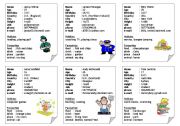
|
ID cards (set of twelve) 1 of 3
DO NOT DOWNLOAD THIS WORKSHEET - instead, download http://www.eslprintables.com/printable.asp?id=327816#thetop, which has all 36 cards in one download.
ID cards possible uses (these instructions are attached to every download)
Getting to know you
Getting to know you is something you can only do with new groups. With the help of these ID cards, students can pretend to be someone else and share this new information.
How to:
- Let students mill around and get to know each other;
- Let students interview each other and record the data on a blank ID card;
- Let students create their own fictional identities on the blank template;
Pre-teach questions forms. Possible questions:
- Whats your name?
- How old are you?
- Whens your birthday?
- Where are you from?
- Where do you live?
- How tall are you?
- Whats your job? or
- What do you do?
- What are your hobbies? or
- What do you do in your free time?
- Whats your favourite (food/drink/place/animal)?
Go Fish
Print two copies of the ID cards on sturdy paper (if possible laminate) and play Go Fish with any of the chosen categories on the ID cards (e.g. countries, names, etc.)
Rules:
Deal 5 cards, or 7 if there are only 2 players. The player whose turn it is asks another player for a card.
For example, "Matt, do you have someone from Spain?" or Have you got someone named John Smith?
If the player doesnt have that card, he says "Go fish" and the asking player draws a card from the pack.
The turn then passes to the next player.
When a player has a pair, the cards are placed face up on the table.
The game ends when all pairs are formed. The winner is the player who won the most pairs. If the player whose turn it is has no cards left in hand, he simply draws the top card from the pack and the turn passes.
Alternatively, the player who gets rid of his cards the quickest wins.
Level:elementary
Age: 6-17
Downloads:85 |
|
Copyright 23/3/2009 Philip Roeland
Publication or redistribution of any part of this
document is forbidden without authorization of the
copyright owner.
|


see more worksheets by PhilipR
|